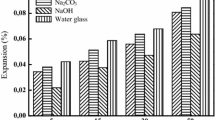Abstract
Cement industry consumes annually around 5% of total industrial energy and results in about 8% of the total global carbon dioxide emissions. Therefore, there is a burgeoning interest in finding alternative binders with lower environmental impacts. Among several promising alternatives, alkali-activated materials (AAMs) are attractive for many researchers. However, there are many concerns about the suitability and accuracy of conventional testing methods for evaluating AAM performance. One of the common concrete degradation mechanism in Quebec is the alkali-silica reaction. Many tests are available for evaluating aggregate reactivity. However, the accelerated mortar bar test is being used extensively due to its short testing duration. Therefore, this paper provides a review of the history of the mortar bar test, highlighting concerns about its feasibility for testing AAM.
Access this chapter
Tax calculation will be finalised at checkout
Purchases are for personal use only
Similar content being viewed by others
References
Alaejos P, Lanza V, Bermúdez MA, Velasco A (2014) Effectiveness of the accelerated mortar bar test to detect rapid reactive aggregates (including their pessimum content) and slowly reactive aggregates. Cem Concr Res 58:13–19
Bakharev T (2005) Geopolymeric materials prepared using Class F fly ash and elevated temperature curing. Cem Concr Res 35:1224–1232
Bérubé MA, Duchesne J, Dorion JF, Rivest M (2002) Laboratory assessment of alkali contribution by aggregates to concrete and application to concrete structures affected by alkali-silica reactivity. Cem Concr Res 32:1215–1227
Bulteel D, Garcia-Diaz E, Vernet C, Zanni H (2002) Alkali-silica Reaction: A Method to Quantify the Reaction Degree. Cem Concr Res 32:1199–1206
Chatterji S (1978) An accelerated method for the detection of alkali-aggregate reactivities of aggregates. Cem Concr Res 8(5):647–650
Comby-Perot F, Bernard P-O, Bouchard F, Bay E-D (2009) Development and validation of a 3D computational tool to describe concrete behaviour at mesoscale. Application to the alkali–silica reaction. Comput Mater Sci 46(4):1163–1177
Donnell KM, Zoughi R, Kurtis KE (2013) Demonstration of microwave method for detection of alkali–silica reaction (ASR) gel in cement-based materials. Cem Concr Res 44:1–7
Fernández-Jiménez A, Puertas F (2002) The alkali-silica reaction in alkali-activated granulated slag mortars with reactive aggregate. Cem Concr Res 32:1019–1024
Fournier B, Berube MA (1991) Application of the NBRI accelerated mortar bar test to siliceous carbonate aggregates produced in the St. Lawrence lowlands Part 2: proposed limits, rates of expansion, and microstructure of reaction products. Cem Concr Res 21:1069–1082
Fournier B, Bérubé MA (1993) General notions on alkali-aggregate reactions. Petrography and Alkali-Aggregate Reactivity, CANMET, Ottawa, Canada
Golmakani F, Hooton RD (2019) Impact of pore solution concentration on the accelerated mortar bar alkali-silica reactivity test. Cem Concr Res 12:72–80. https://doi.org/10.1016/j.cemconres.2019.02.008
Helmuth R (1993) Alkali-Silica reactivity: an overview of research. washington: strategic highway research program SHRP-C-342, National Research Council. Dent Glasser & Kataoka, 1982
Hooton RD, Rogers CA (1992) The development of the NBRI rapid mortar bar test leading to its use in north America. In: 9th international conference on Alkali-aggregate reaction in concrete, pp 461–467
Huang G, Zhang L, Li J, Hou Z (2018) "The influence of curing methods on the strength of MSWI bottom ash-based alkali-activated mortars: the role of leaching of OH and free alkali. Constr Build Mater 186:978–985
Jensen V (1996) Present experience with aggregate testing in Norway. In: 10th international conference on Alkali-aggregate reaction in concrete, pp 133–142
Kawabata Y, Yamada K, Sagawa Y, Ogawa S (2018) Alkali-wrapped concrete prism test (AW-CPT)–new testing protocol toward a performance test against alkali-silica reaction. J Adv Concr Technol 16:441–460
Khan M, Saha AK, Sarker PK (2021) Evaluation of the ASR of waste glass fine aggregate in alkali activated concrete by concrete prism tests. Constr Build Mater 266, Part B: Article 121121
Kuroda T, Inoue S, Yoshino A (2000) ASR expansion characteristics of mortar bars immersed in NaOH solution by autoclave method. In: 11th international conference on alkali aggregate reaction, pp 375–384
Kurtis KE, Collins CL, Monteiro PJ (2002) The surface chemistry of the alkali-silica reaction: a critical evaluation and x-ray microscopy. Concrete Sci Eng 4:11
Mahanama D, De Silva P, Kim T, Castel A, Khan MSH (2019) Evaluating effect of GGBFS in alkali-silica reaction in geopolymer mortar with accelerated mortar bar test. J Mater Civ Eng 31:1–11. https://doi.org/10.1061/(ASCE)MT.1943-5533.0002804
Multon S, Sellier A, Cyr M (2009) Chemo–mechanical modeling for prediction of alkali silica reaction (ASR) expansion. Cem Concr Res 39:490–500
Saha AK (2018) A comparative study between ASTM C1567 and ASTM C227 to mitigate alkali-silica reaction. Struct Concr 20(1):420–427
US Army Corps of Engineers (1994) Alkali–Silica aggregate reactions: standard practice for concrete for civil works. US Army Corps of Engineers Headquarters, Washington, DC, USA, EM 1110-2-2000
Visser JHM (2002) Fundamentals of alkali-silica gel formation and swelling: condensation under influence of dissolved salts. Cem Concr Res 105:18–30
Wang W, Noguchi T (2020) Alkali-silica reaction (ASR) in the alkali-activated cement (AAC) system: a state-of-the-art review. Constr Build Mater 252. Article 119105
Xie Z, Xiang W, Xi Y (2003) ASR potentials of glass aggregates in water-glass activated fly ash and Portland cement mortars. J Mater Civ Eng 15:67–74
Author information
Authors and Affiliations
Editor information
Editors and Affiliations
Rights and permissions
Copyright information
© 2023 Canadian Society for Civil Engineering
About this paper
Cite this paper
Martinez, A., Fournier, B., Soliman, A., Diab, S. (2023). Mortar Bar Test for Reactive Aggregate Detection: A Review. In: Walbridge, S., et al. Proceedings of the Canadian Society of Civil Engineering Annual Conference 2021 . CSCE 2021. Lecture Notes in Civil Engineering, vol 239. Springer, Singapore. https://doi.org/10.1007/978-981-19-0503-2_35
Download citation
DOI: https://doi.org/10.1007/978-981-19-0503-2_35
Published:
Publisher Name: Springer, Singapore
Print ISBN: 978-981-19-0502-5
Online ISBN: 978-981-19-0503-2
eBook Packages: EngineeringEngineering (R0)



